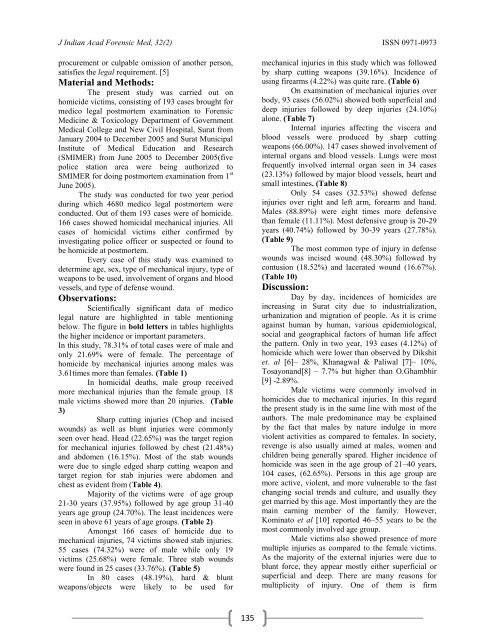jiafm, 2010-32(2) april-june. - forensic medicine
jiafm, 2010-32(2) april-june. - forensic medicine
jiafm, 2010-32(2) april-june. - forensic medicine
- No tags were found...
Create successful ePaper yourself
Turn your PDF publications into a flip-book with our unique Google optimized e-Paper software.
J Indian Acad Forensic Med, <strong>32</strong>(2) ISSN 0971-0973procurement or culpable omission of another person,satisfies the legal requirement. [5]Material and Methods:The present study was carried out onhomicide victims, consisting of 193 cases brought formedico legal postmortem examination to ForensicMedicine & Toxicology Department of GovernmentMedical College and New Civil Hospital, Surat fromJanuary 2004 to December 2005 and Surat MunicipalInstitute of Medical Education and Research(SMIMER) from June 2005 to December 2005(fivepolice station area were being authorized toSMIMER for doing postmortem examination from 1 stJune 2005).The study was conducted for two year periodduring which 4680 medico legal postmortem wereconducted. Out of them 193 cases were of homicide.166 cases showed homicidal mechanical injuries. Allcases of homicidal victims either confirmed byinvestigating police officer or suspected or found tobe homicide at postmortem.Every case of this study was examined todetermine age, sex, type of mechanical injury, type ofweapons to be used, involvement of organs and bloodvessels, and type of defense wound.Observations:Scientifically significant data of medicolegal nature are highlighted in table mentioningbelow. The figure in bold letters in tables highlightsthe higher incidence or important parameters.In this study, 78.31% of total cases were of male andonly 21.69% were of female. The percentage ofhomicide by mechanical injuries among males was3.61times more than females. (Table 1)In homicidal deaths, male group receivedmore mechanical injuries than the female group. 18male victims showed more than 20 injuries. (Table3)Sharp cutting injuries (Chop and incisedwounds) as well as blunt injuries were commonlyseen over head. Head (22.65%) was the target regionfor mechanical injuries followed by chest (21.48%)and abdomen (16.15%). Most of the stab woundswere due to single edged sharp cutting weapon andtarget region for stab injuries were abdomen andchest as evident from (Table 4).Majority of the victims were of age group21-30 years (37.95%) followed by age group 31-40years age group (24.70%). The least incidences wereseen in above 61 years of age groups. (Table 2)Amongst 166 cases of homicide due tomechanical injuries, 74 victims showed stab injuries.55 cases (74.<strong>32</strong>%) were of male while only 19victims (25.68%) were female. Three stab woundswere found in 25 cases (33.76%). (Table 5)In 80 cases (48.19%), hard & bluntweapons/objects were likely to be used formechanical injuries in this study which was followedby sharp cutting weapons (39.16%). Incidence ofusing firearms (4.22%) was quite rare. (Table 6)On examination of mechanical injuries overbody, 93 cases (56.02%) showed both superficial anddeep injuries followed by deep injuries (24.10%)alone. (Table 7)Internal injuries affecting the viscera andblood vessels were produced by sharp cuttingweapons (66.00%). 147 cases showed involvement ofinternal organs and blood vessels. Lungs were mostfrequently involved internal organ seen in 34 cases(23.13%) followed by major blood vessels, heart andsmall intestines. (Table 8)Only 54 cases (<strong>32</strong>.53%) showed defenseinjuries over right and left arm, forearm and hand.Males (88.89%) were eight times more defensivethan female (11.11%). Most defensive group is 20-29years (40.74%) followed by 30-39 years (27.78%).(Table 9)The most common type of injury in defensewounds was incised wound (48.30%) followed bycontusion (18.52%) and lacerated wound (16.67%).(Table 10)Discussion:Day by day, incidences of homicides areincreasing in Surat city due to industrialization,urbanization and migration of people. As it is crimeagainst human by human, various epidemiological,social and geographical factors of human life affectthe pattern. Only in two year, 193 cases (4.12%) ofhomicide which were lower than observed by Dikshitet. al [6]– 28%, Khanagwal & Paliwal [7]– 10%,Tosayonand[8] – 7.7% but higher than O.Ghambhir[9] -2.89%.Male victims were commonly involved inhomicides due to mechanical injuries. In this regardthe present study is in the same line with most of theauthors. The male predominance may be explainedby the fact that males by nature indulge in moreviolent activities as compared to females. In society,revenge is also usually aimed at males, women andchildren being generally spared. Higher incidence ofhomicide was seen in the age group of 21–40 years,104 cases, (62.65%). Persons in this age group aremore active, violent, and more vulnerable to the fastchanging social trends and culture, and usually theyget married by this age. Most importantly they are themain earning member of the family. However,Kominato et al [10] reported 46–55 years to be themost commonly involved age group.Male victims also showed presence of moremultiple injuries as compared to the female victims.As the majority of the external injuries were due toblunt force, they appear mostly either superficial orsuperficial and deep. There are many reasons formultiplicity of injury. One of them is firm135



![syllabus in forensic medicine for m.b.b.s. students in india [pdf]](https://img.yumpu.com/48405011/1/190x245/syllabus-in-forensic-medicine-for-mbbs-students-in-india-pdf.jpg?quality=85)



![SPOTTING IN FORENSIC MEDICINE [pdf]](https://img.yumpu.com/45856557/1/190x245/spotting-in-forensic-medicine-pdf.jpg?quality=85)

![JAFM-33-2, April-June, 2011 [PDF] - forensic medicine](https://img.yumpu.com/43461356/1/190x245/jafm-33-2-april-june-2011-pdf-forensic-medicine.jpg?quality=85)



![JIAFM-33-4, October-December, 2011 [PDF] - forensic medicine](https://img.yumpu.com/31013278/1/190x245/jiafm-33-4-october-december-2011-pdf-forensic-medicine.jpg?quality=85)


